How Fantasia injected new life into “The Color Purple”: 'I got to do it one more time'
- Oops!Something went wrong.Please try again later.
- Oops!Something went wrong.Please try again later.
- Oops!Something went wrong.Please try again later.
- Oops!Something went wrong.Please try again later.
- Oops!Something went wrong.Please try again later.
Even star Fantasia Barrino and her director, Blitz Bazawule, didn't see the need to revisit 'The Color Purple' on screen. Then everything changed.
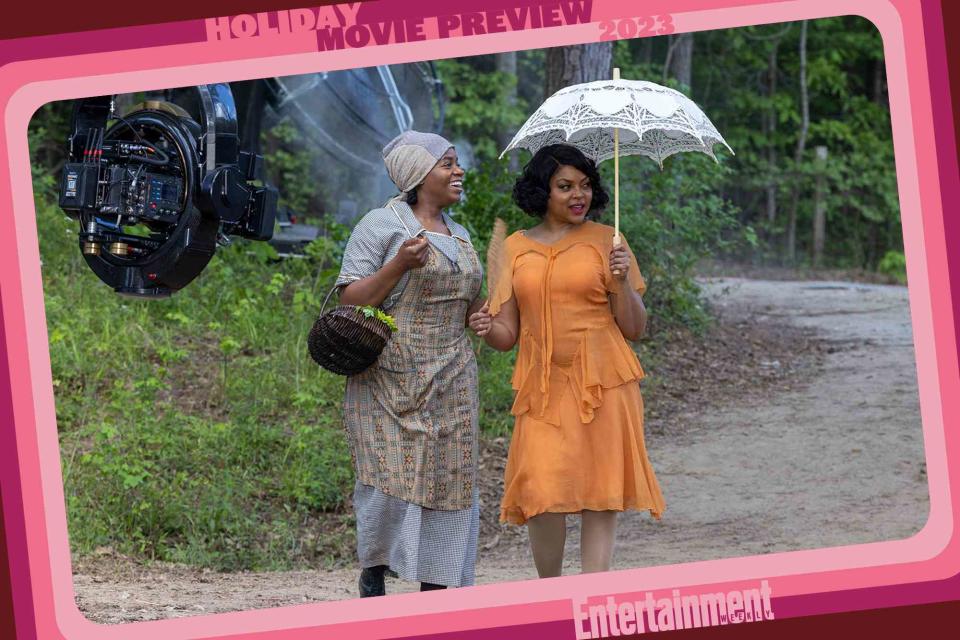
Lynsey Weatherspoon
Fantasia and Taraji P. Henson on the set of 'The Color Purple'You’d be forgiven if your initial thought upon hearing about the new version of The Color Purple is “why?” After all, that’s how director Blitz Bazawule and star Fantasia Barrino felt about it.
“This film is a classic. The play is a classic. The book is a classic. What is left for me?” Bazawule recalls thinking when he first heard about the opportunity. Barrino went further and declined the role in the beginning. "At first I felt like, 'Why are we touching it?'" the actress admits. She had already played the part of Celie on Broadway to great acclaim and wasn’t eager to do it again. “What I felt and carried stepping into her shoes and playing her role, I wasn't ready to go back to that,” Barrino reveals.
Even after reading the script, Bazawule remained unconvinced — until he went back to the source text, Alice Walker’s Pulitzer Prize-winning 1982 novel, which he had first read while a student at Kent State. He realized the book “truly is an endless well,” as he puts it, and with this adaptation he could visually expand on Walker’s ideas in a way that no iteration had done before.
Bazawule, whose previous work includes the Ghanaian drama The Burial of Kojo and segments of Beyoncé’s Black Is King, shared his vision with Barrino, who says she “fell in love with the fact that he gave Celie an imagination.”
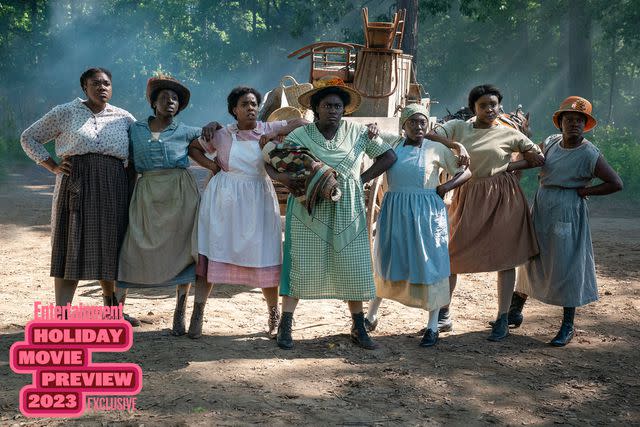
Eli Ade´
A scene from 'The Color Purple'Celie suffers decades of physical and emotional abuse at the hands of her domineering husband she’s forced to call “Mister,” played by Colman Domingo (Fear the Walking Dead, Rustin), but she is still capable of love and joy and hope, embodied by her kinship with Sofia (Peacemaker's Danielle Brooks) and Shug Avery (Empire's Taraji P. Henson). Bazawule wanted to render Celie’s interior life in a way only movie musicals can, and that was enough to hook his eventual leading lady.
“Blitz showed me, I'm giving her an imagination so that the people will be able to see certain things. And I said, ‘Well, you got me. You got me. I got to do it one more time,’” Barrino recalls. “What Blitz is coming with with this Color Purple, it’s necessary for this generation," she adds. "And the twist that he puts on it... I feel like he handpicked every last one of us perfectly because Taraji really is Shug, and Danielle, she is Sofia. I was just honored to even be in the presence of some real actors and actresses who bring it. They gave me exactly what I needed to play Celie.”
The Color Purple has had a long, rich cultural life since its publication in 1982. Steven Spielberg directed the 1985 film adaptation, starring Whoopi Goldberg (in her film debut) as Celie with Oprah Winfrey (also in her debut) as Sofia, Danny Glover as Mister, and Margaret Avery as Shug. Nominated for 11 Oscars, including Best Picture, it — rather infamously — won none. Winfrey, who has been vocal about the profound impact Walker’s novel had on her, named her production company Harpo, after her husband in the film, played by Willard Pugh.
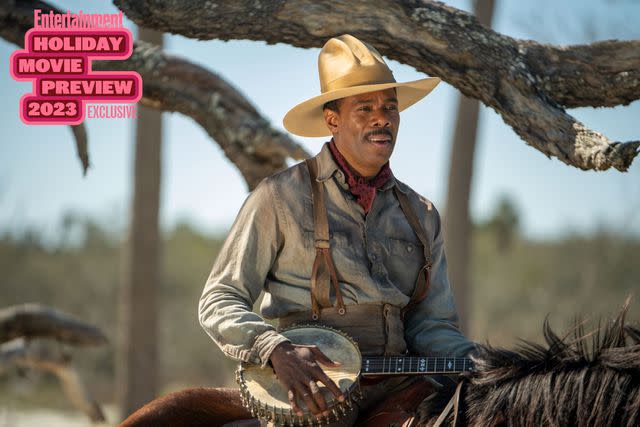
Eli Ade´
Colman Domingo in 'The Color Purple'"The Color Purple changed the trajectory of my life," Winfrey said during a Q&A with Bazawule after a screening of the trailer back in May. "It was the beginning of the ascension of everything that happened in my life.”
Winfrey was also instrumental in bringing the original production of the musical adaptation — with music and lyrics by Brenda Russell, Allee Willis, and Stephen Bray, and a book by Marsha Norman — to Broadway in 2005. LaChanze starred as Celie, winning a Tony for Best Actress in a Musical. When Barrino took over for her in 2007, the American Idol alum was honored with a Theatre World Award for her Broadway debut.
Ten years later, The Color Purple went back to Broadway, starring Cynthia Erivo as Celie and Danielle Brooks as Sofia, with Erivo winning the Best Actress in a Musical Tony and the play winning Best Revival of a Musical. So, with that kind of track record, perhaps a cinematic adaptation of the musical was inevitable, after all.
This time, Winfrey and Spielberg serve as producers, along with one of the original film’s producers, Quincy Jones, and Scott Sanders, who produced both Broadway versions of the musical. Barrino — who, like Goldberg, is making her film debut as Celie — along with Henson, Domingo, and Brooks lead an all-star cast that includes Halle Bailey, Ciara, H.E.R., Corey Hawkins, Aunjanue Ellis, Jon Batiste, David Alan Grier, and Louis Gossett Jr.
Fantasia Barrino and Blitz Bazawule discuss taking on a literary legacy, giving Taraji P. Henson her flowers, and being regularly brought to tears of joy.
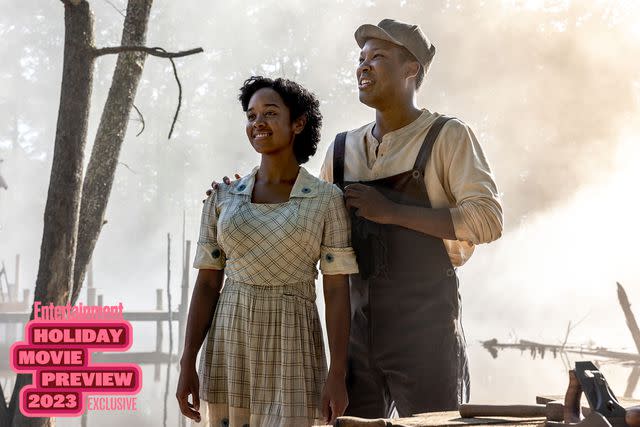
Lynsey Weatherspoon
H.E.R. and Corey Hawkins in 'The Color Purple'ENTERTAINMENT WEEKLY: Fantasia, how did you approach the role change, and how have you grown as a performer since the Broadway version?
FANTASIA BARRINO: It changed with me. I'm not the same girl. I have a different lens. See, the way I saw it on Broadway was, my life was in shambles and Celie's was, too, so it was heavy. I was not only playing her, but I was living that life: so young, not having the right team with you, making all the wrong mistakes, trying to find love in all the wrong places. You know the drill. So, I'm out there like, Oh, this is too much. But now that I'm sitting pretty, now that I'm older, now that I'm wiser, now that I do therapy, now that I do the things that I need to do for myself and allow growth, Celie grew. I was sitting on set like, Yo, that's what's up. I don't see it the same way I saw it on Broadway.
Can you tell me what the vibe was like the first day on set?
BLITZ BAZAWULE: The very first shot of our very first day is in my movie, which says everything. It's the girls running towards the tree... It's in our opening shot, after we leave the tree and our girls run and then we boom up to the sky and we see the title. It was with Halle Bailey and Phylicia Pearl Mpasi. We were excited [for] the journey we were about to embark on. We knew that it was going to be an arduous one ahead of us, but I feel like we were well rehearsed and came in swinging. I'm really grateful for that day because it set the tone for the rest of the movie.
There were several scenes when I was watching this that made me very emotional, but especially when Fantasia sings “I'm Here.” What was it like filming that scene?
BAZAWULE: Oh my goodness, are you kidding me? It was tears galore, even the mundane stuff, because I'm watching people who were due their flowers for a very long time. I know what this is going to do for Taraji. I've known Taraji's mastery of the craft forever, and the world has known about it, but not on this level, where she, in fact, uses all her gifts. We know Colman's a master, but what Colman brings in this film, I don't think anyone's seen that from him before. Fantasia doing “I'm Here” was so epic that some cast members came to watch it. I remember Halle, Phylicia came. It was a spectacle. We were all waiting for Fantasia to sing “I'm Here.” My choice, cinematically, was to get everything out of the way, just let her do her thing. It'll be a stripped-down moment where this woman bares her soul. And also, she sang live.
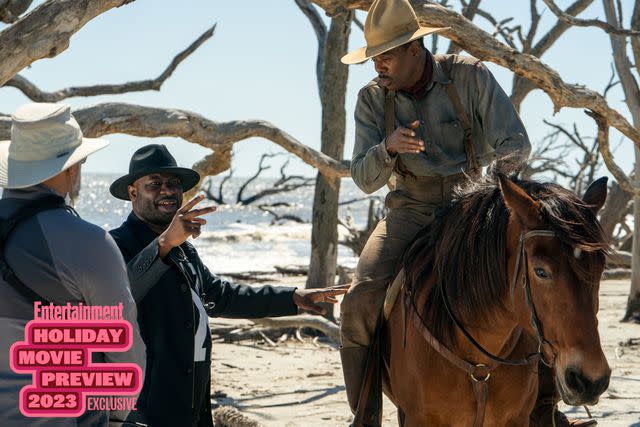
Eli Ade´
Blitz Bazawule (center) and Colman Domingo (right) on the set of 'The Color Purple'Oh, really?
BARRINO: I sung that live about a hundred times — at 5 o'clock in the morning, in the cold, in Macon, Ga. I'm a Cancer in real life, and I always say that Celie was too because she wanted to take care of everybody. She took a licking and she kept on ticking. She dealt with certain people that did her wrong, but she still turned around and loved on them. Every time I would get through singing, somebody would literally come up to me and say something like, "Man, thank you. When you sang that part, it touched me because I'm this, I'm that." Although I was so tired, it was intentional for me to sing it live. People were sitting around and watching and being blessed by it because that song has something in it that everybody can relate to.
BAZAWULE: How many people can do that? Most people are dubbed. Most people use pre-records. That whole [scene], that's all just her. Was I emotional? Bro, I was in tears. We all were.
What are you most proud of your experience with making this film?
BARRINO: I feel like there was once a time in my career where things were not so good. Days were not so bright, but I kept going and I never gave up. Through Celie, I caught my breakthrough and I'm grateful for that. If they can't see it through me, then I allow myself to be a vessel so they can see it through Celie. I'm most proud of myself for standing up and doing things that I never thought I could do and bouncing back. It feels like Idol again. But I'm just wiser. I'm grown now.
The Color Purple will play in theaters starting Dec. 25.
This interview has been edited for clarity and brevity.
Want more movie news? Sign up for Entertainment Weekly's free newsletter to get the latest trailers, celebrity interviews, film reviews, and more.
Related content:
Put your shoulders back and look The Color Purple trailer straight in the eye 'cause it...is...here
See new cast of The Color Purple next to stars of original movie in same roles
The Color Purple could turn into Oscars gold as cast heats up Best Supporting Actress race
Watch Danielle Brooks' emotional reaction to Oprah telling her she landed The Color Purple role
Read the original article on Entertainment Weekly.

